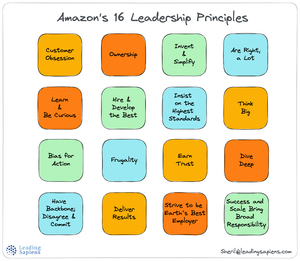Whether you're preparing for an interview at Amazon, or a leader wanting to get better, there’s something for everyone to learn from Amazon’s leadership principles.
These principles turn the often vague concept of leadership into a practical and tactical set of behaviors that anyone can follow. Of course, simple doesn’t mean easy. If anything, they set the bar much higher.
In this article, I explore all 16 of Amazon’s leadership principles. I link it with Bezos’ own words, and also with other articles that build on the concepts. At the end, I give a comprehensive list of reading recommendations and useful links.
The article is heavily interlinked, and with accompanying videos. Use the table of contents to keep you on track. It covers the following:
- The leadership principles
- How they are different
- Deep dive into each principle
- Andy Jassy on iterative innovation
- Interviewing tips, reading recommendations and resources
Amazon's Leadership Principles
- Customer Obsession. Leaders start with the customer and work backwards. They work vigorously to earn and keep customer trust. Although leaders pay attention to competitors, they obsess over customers.
- Ownership. Leaders are owners. They think long term and don’t sacrifice long-term value for short-term results. They act on behalf of the entire company, beyond just their own team. They never say, “that’s not my job.”
- Invent and Simplify. Leaders expect and require innovation and invention from their teams and always find ways to simplify. They are externally aware, look for new ideas from everywhere, and are not limited by “not invented here.” As we do new things, we accept that we may be misunderstood for long periods of time.
- Are Right, A Lot. Leaders are right a lot. They have strong judgment and good instincts. They seek diverse perspectives and work to disconfirm their beliefs.
- Learn and Be Curious. Leaders are never done learning and always seek to improve themselves. They are curious about new possibilities and act to explore them.
- Hire and Develop the Best. Leaders raise the performance bar with every hire and promotion. They recognize exceptional talent, and willingly move them throughout the organization. Leaders develop leaders and take seriously their role in coaching others. We work on behalf of our people to invent mechanisms for development like Career Choice.
- Insist on the Highest Standards. Leaders have relentlessly high standards—many people may think these standards are unreasonably high. Leaders are continually raising the bar and drive their teams to deliver high-quality products, services, and processes. Leaders ensure that defects do not get sent down the line and that problems are fixed so they stay fixed.
- Think Big. Thinking small is a self-fulfilling prophecy. Leaders create and communicate a bold direction that inspires results. They think differently and look around corners for ways to serve customers.
- Bias for Action. Speed matters in business. Many decisions and actions are reversible and do not need extensive study. We value calculated risk-taking.
- Frugality. Accomplish more with less. Constraints breed resourcefulness, self-sufficiency, and invention. There are no extra points for growing headcount, budget size, or fixed expense.
- Earn Trust. Leaders listen attentively, speak candidly, and treat others respectfully. They are vocally self-critical, even when doing so is awkward or embarrassing. Leaders do not believe their or their team’s body odor smells of perfume. They benchmark themselves and their teams against the best.
- Dive Deep. Leaders operate at all levels, stay connected to the details, audit frequently, and are skeptical when metrics and anecdotes differ. No task is beneath them.
- Have Backbone; Disagree and Commit. Leaders are obligated to respectfully challenge decisions when they disagree, even when doing so is uncomfortable or exhausting. Leaders have conviction and are tenacious. They do not compromise for the sake of social cohesion. Once a decision is determined, they commit wholly.
- Deliver Results. Leaders focus on the key inputs for their business and deliver them with the right quality and in a timely fashion. Despite setbacks, they rise to the occasion and never settle.
How they are different
At the outset, except for a couple, these might read like standard corporate-speak that you find at every other company. But that would be a mistake. They are fundamentally different in many ways:
- Amazon takes these to another level by outlining behaviors that go with each principle.
- They use plain language that's easy to read, remember, and communicate. More importantly, they are simple to follow. But this doesn't mean they are easy.
- By outlining principles as behaviors couched in simple language, it makes them actionable and more likely to be used.
- All their processes support and build on the principles that are deeply embedded. They can be thought of as the operating system or constitution that everyone follows.
- Many find them quirky and unnecessary. But that’s precisely the point. You either fit in or you don’t.
Having a set of easily understood and readily teachable set of practices plays a key role in how effectively desired behaviors get scaled across the organization. Culture thus becomes scalable and measurable. They have essentially operationalized leadership and baked it into their culture.
Let's look at each principle more closely.
1. Customer Obsession
Leaders start with the customer and work backwards. They work vigorously to earn and keep customer trust. Although leaders pay attention to competitors, they obsess over customers.
In Bezos’ own words:
- "...obsessive customer focus is by far the most protective of Day 1 vitality"
- ...our energy at Amazon comes from the desire to impress customers rather than the zeal to best competitors
- I constantly remind our employees to be afraid ... of our customers.
- One advantage...of a customer-driven focus is that it aids a certain type of proactivity.
Examples:
- In the early days, Bezos was known to bring an empty chair into meetings to remind everyone of the voice of the customer.
- Amazon managers are often required to do two days of call center training.
- An Amazon team once procured 4,000 pink iPods from the open market themselves, due to Apple not being able to fulfill their order.
Some pointers:
- Amazon’s mission states: “We strive to offer our customers the lowest possible prices, the best available selection, and the utmost convenience.” Its vision states: “To be Earth’s most customer-centric company, where customers can find and discover anything they might want to buy online.” Clearly, customer obsession is number one for a reason. It features prominently in almost everything Bezos has written, and all the principles support this primary one.
- Staying close to the voice of your customer is key to business success. Here are a couple of ideas: Management by wandering around (MBWA) and Andy Grove's idea of balancing top-down and bottom-up approaches to strategy and leadership.
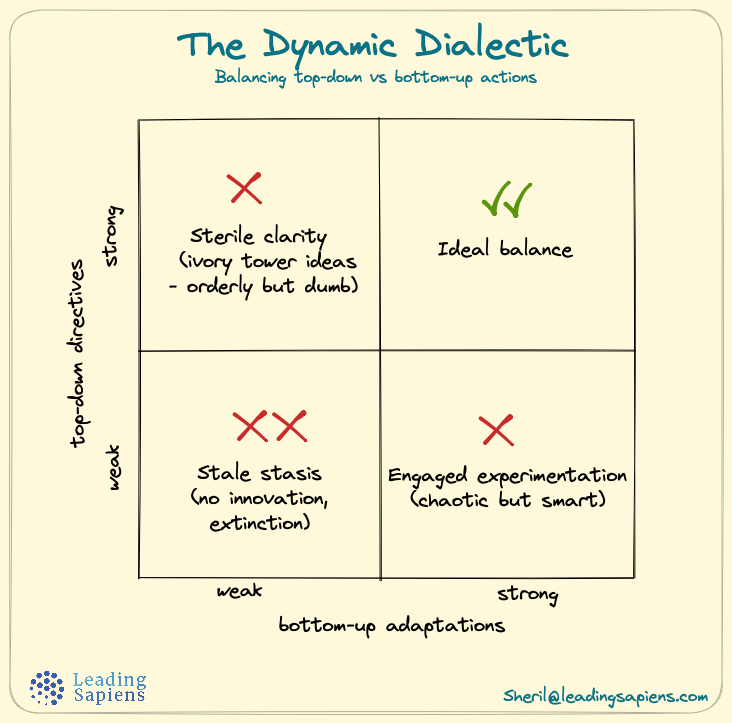
Customer Obsession Video:
2. Ownership
Leaders are owners. They think long term and don’t sacrifice long-term value for short-term results. They act on behalf of the entire company, beyond just their own team. They never say, “that’s not my job.”
In Bezos’ own words:
Long-term thinking is both a requirement and an outcome of true ownership. Owners are different from tenants. I know of a couple who rented out their house, and the family who moved in nailed their Christmas tree to the hardwood floors instead of using a tree stand. Expedient, I suppose, and admittedly these were particularly bad tenants, but no owner would be so short-sighted. Similarly, many investors are effectively short-term tenants, turning their portfolios so quickly they are really just renting the stocks that they temporarily “own.”
- Seek instant gratification—or the elusive promise of it—and chances are you’ll find a crowd there ahead of you.
- ...you can build a business strategy around the things that are stable in time
Some pointers:
- When everyone else is thinking short-term, your willingness to think long-term becomes a competitive advantage in itself. But what does long-term thinking mean at all levels of an organization? This is where Bezos' analogy of an ownership mentality is useful.
- Having an owner's mentality also means not just taking responsibility for failures, but also taking ownership of dependencies. John Rossman puts it this way:
At Amazon, one of your primary directives is to identify and tenaciously manage every potential business-derailing dependency you have. It is not okay to fail because of a breakdown of dependencies....Taking absolute responsibility for every possible dependency under your purview is no small task. This is one reason that very few have the rigor, determination, and tenacity to make it in a leadership role at Amazon.
– John Rossman [7]
Rossman elaborates in an article:
You are always dependent upon others in business – other teams, partners, vendors, products, services. The mentality of “managing your dependencies’’ is key to being a leader at Amazon. ... I am often asked how it’s accomplished.
While there are many ways, start by asking a lot more and deeper questions than you normally do with your colleagues. Secondly, don’t just trust. Instead, trust and verify. When this becomes the norm in a company, then asking for details is no longer seen as a challenge to someone’s competency. Finally, create and manage service level commitments on all capabilities – and hold your partners accountable.
Ownership Video:
3. Invent and Simplify
Leaders expect and require innovation and invention from their teams and always find ways to simplify. They are externally aware, look for new ideas from everywhere, and are not limited by “not invented here.” As we do new things, we accept that we may be misunderstood for long periods of time.
In Bezos’ own words:
- Good process is absolutely essential. Without defined processes, you can’t scale, you can’t put metrics and instrumentation in place, you can’t manage. But avoiding bureaucracy is essential. Bureaucracy is process run amok.
- ...you need to distinguish between those two types of failure and really be seeking invention and innovation.
- Most large organizations embrace the idea of invention but are not willing to suffer the string of failed experiments necessary to get there.
- Listen to customers, but don’t just listen to customers—also invent on their behalf.
Some pointers:
- It's easy to complicate, and equally harder to keep things simple, especially when you are inventing and innovating at a rapid pace like Amazon. Paralyzing bureaucracy is a natural after-effect of fast growth, and can only be prevented by actively fighting it.
- One way to think about bureaucracy vs simplicity is the difference between leadership as gardening, not chess, that General Stan McChrystal highlights.
- John Rossman [7] calls simplicity as the bulwark against bureaucracy, and gives the following distinctions:
So, how do you recognize bureaucracy and distinguish it from a well-defined process?
When the rules can’t be explained;
when they don’t favor the customer;
when you can’t get redress from a higher authority;
when you can’t get an answer to a reasonable question;
when there is no service-level agreement or guaranteed response time built into the process;
or when the rules simply don’t make sense
—when any of these circumstances occur, the chances are good that bureaucracy is beginning to spread.
Invent and Simplify Video:
4. Are Right, A Lot
Leaders are right a lot. They have strong judgment and good instincts. They seek diverse perspectives and work to disconfirm their beliefs.
In Bezos’ own words:
- People who are right a lot, they listen a lot. And people who are right a lot change their mind a lot. And people who are right a lot, they seek to disconfirm their most profoundly held convictions.
- All my best decisions in business and in life have been made with heart, intuition, and guts, not analysis.
Some pointers:
- Leadership reflection is an effective mechanism to develop judgment and instincts.
- Getting to the right idea means staying open to options, and diverse perspectives. This requires the ability to stay in the discomfort of not jumping to conclusions. It's what John Keats called Negative Capability.
- An effective tool to develop good judgment, and make sure you've taken multiple perspectives, is the ladder of inference:
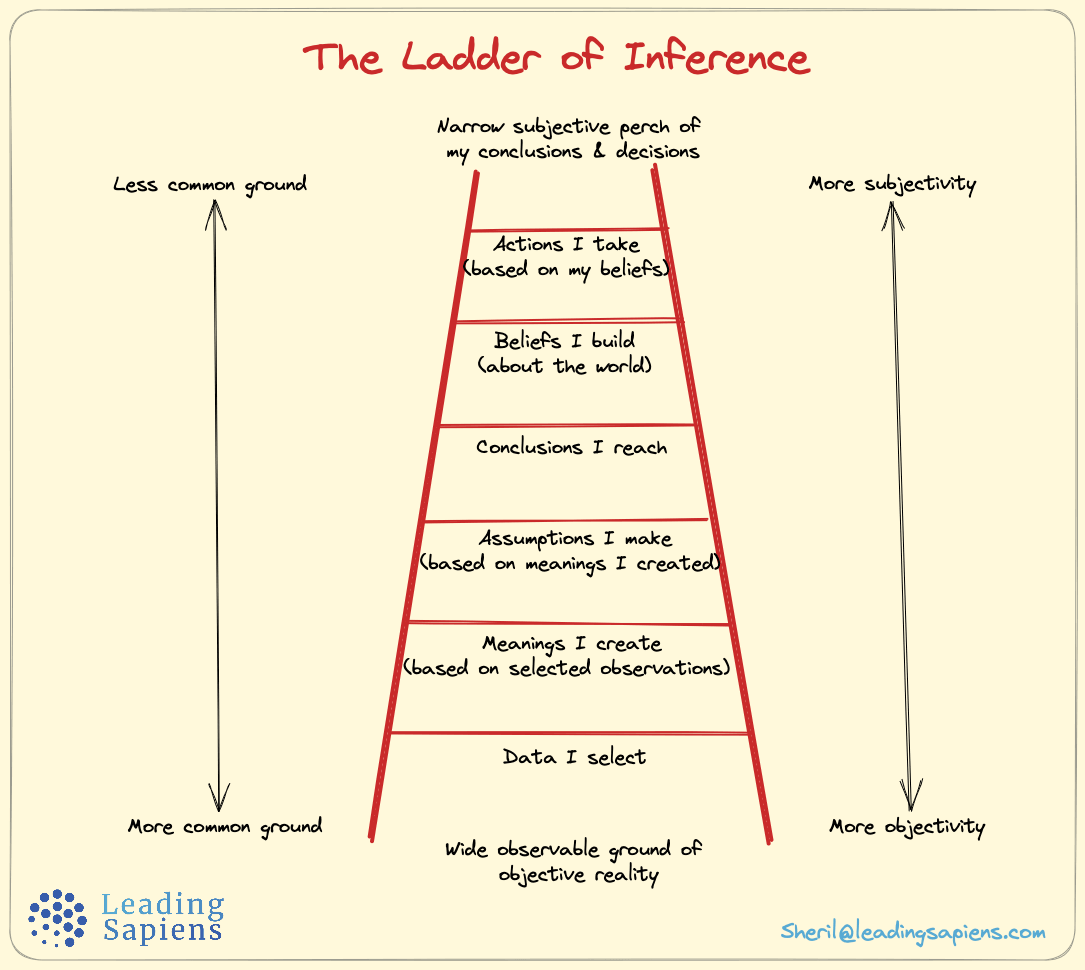
Leaders are Right a Lot Video:
5. Learn and Be Curious
Leaders are never done learning and always seek to improve themselves. They are curious about new possibilities and act to explore them.
In Bezos’ own words:
- From very early on in Amazon’s life, we knew we wanted to create a culture of builders—people who are curious, explorers.
- Wandering is an essential counterbalance to efficiency.
Some pointers:
- Well-educated and highly paid professionals are especially likely to struggle with learning. Learning to learn is an essential skill in itself.
- One reason we struggle is because there's a paradox in real learning – doing what you don't know how to do yet.
- Continously improving and learning requires questioning existing assumptions and hidden mental models. An effective way to this is to learn the double-loop learning framework:
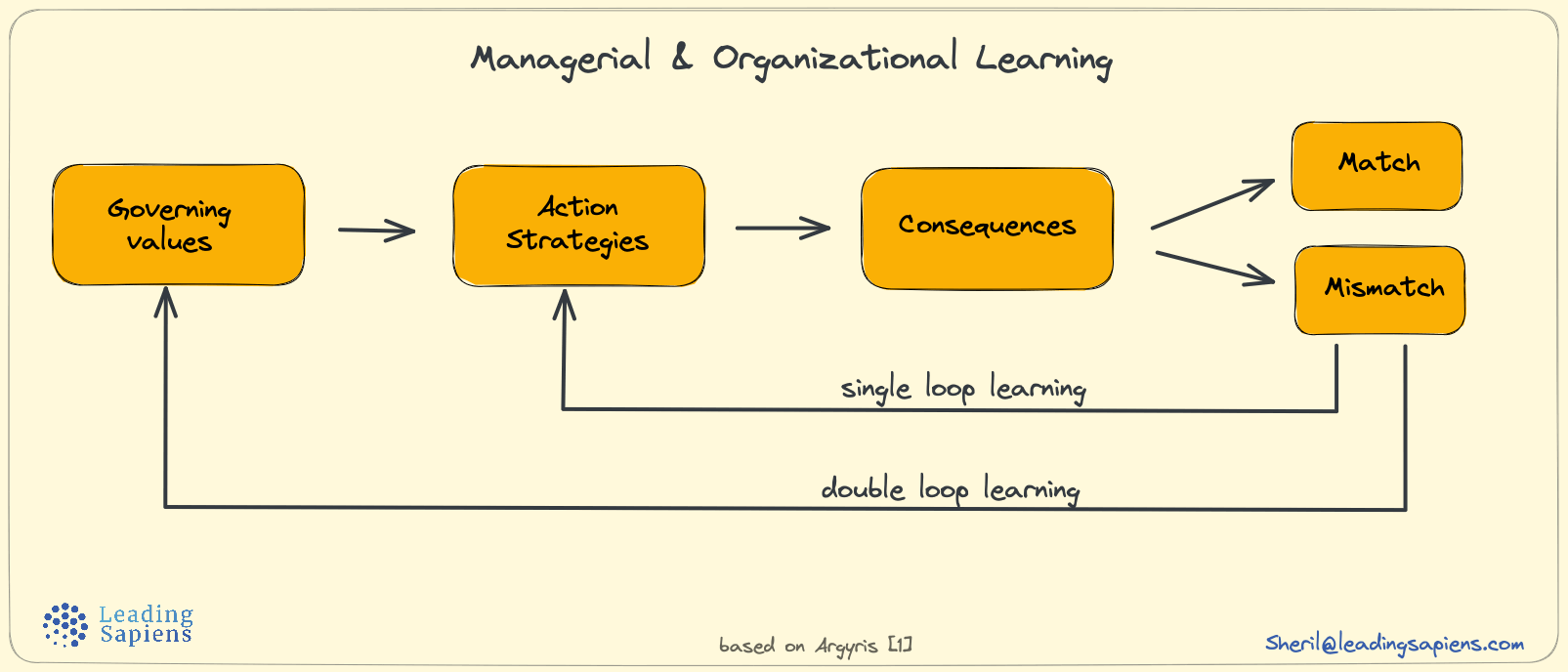
Learn and Be Curious Video:
6. Hire and Develop the Best
Leaders raise the performance bar with every hire and promotion. They recognize exceptional talent, and willingly move them throughout the organization. Leaders develop leaders and take seriously their role in coaching others. We work on behalf of our people to invent mechanisms for development like Career Choice.
In Bezos’ own words:
- You don’t want mercenaries at your company. You want missionaries.
- Setting the bar high in our approach to hiring has been, and will continue to be, the single most important element of Amazon.com’s success.
- The reason cultures are so stable in time is because people self-select.
Some pointers:
- Leaders play a key role in developing other leaders. Leadership can be learned, and coaching plays a key role in this development.
- It's helpful to be aware of your own implicit theories of leadership that influence how you approach emerging leaders, and to your own managers.
- For hiring and retention, leaders have to be aware of the differences between hygiene factors vs motivators:
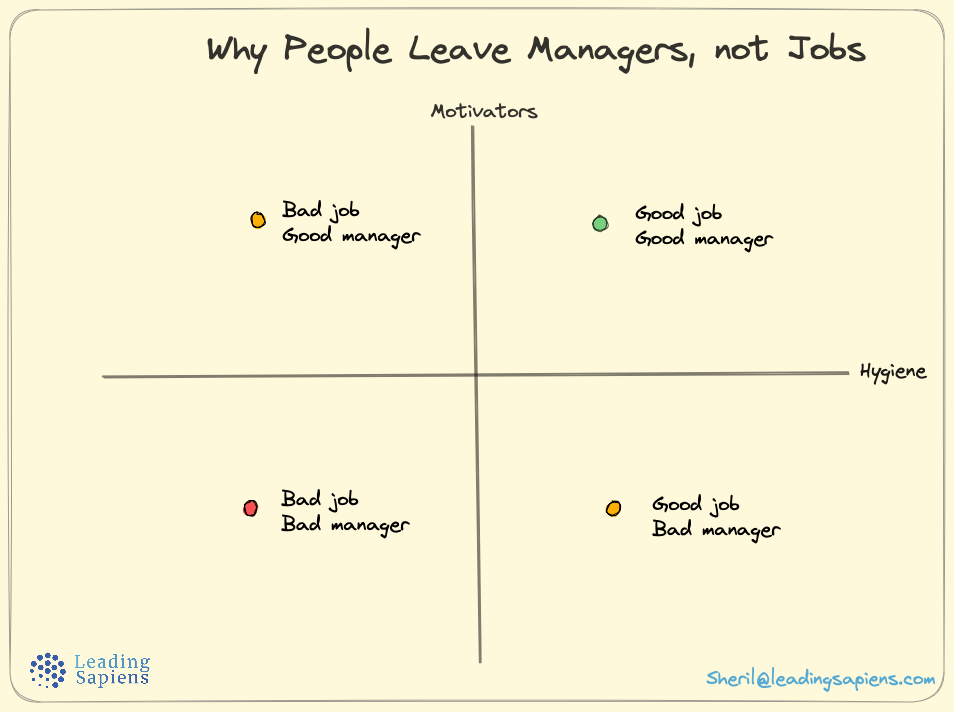
Amazon has faced many of the same problems all companies face. The difference is that Amazon has come up with novel solutions that deliver a significant competitive advantage, and this is true of its approach to hiring. The Bar Raiser process was one of Amazon’s first and most successful scalable, repeatable, and teachable operational practices.
— Colin Bryar, Bill Carr [5]
Hire & Develop the Best Video:
7. Insist on the Highest Standards
Leaders have relentlessly high standards— many people may think these standards are unreasonably high. Leaders are continually raising the bar and drive their teams to deliver high quality products, services and processes. Leaders ensure that defects do not get sent down the line and that problems are fixed so they stay fixed.
In Bezos’ own words:
- "Bring a new person onto a high standards team, and they’ll quickly adapt.
The opposite is also true. If low standards prevail, those too will quickly spread." - "To achieve high standards yourself or as part of a team, you need to form and proactively communicate realistic beliefs about how hard something is going to be."
Some pointers:
- High standards are especially applicable to leadership. Why? Because people copy leaders which has ripples throughout the organization.
- Setting high standards also acts as a framing mechanism that influences how your team responds to novel situations.
- Setting clear expectations goes hand-in-hand with setting high standards:
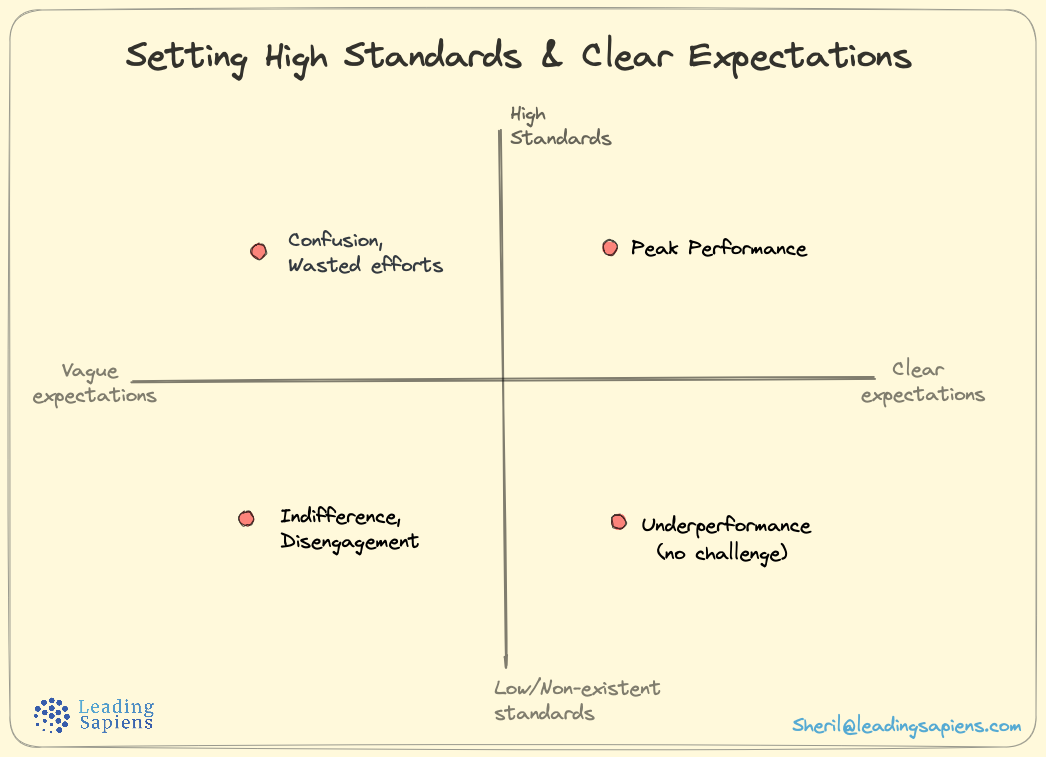
Insist on the Highest Standards Video:
8. Think Big
Thinking small is a self-fulfilling prophecy. Leaders create and communicate a bold direction that inspires results. They think differently and look around corners for ways to serve customers.
In Bezos’ own words:
- ...a single big winning bet can more than cover the cost of many losers.
- This long-tailed distribution of returns is why it’s important to be bold. Big winners pay for so many experiments.
- We will make bold rather than timid investment decisions where we see a sufficient probability of gaining market leadership advantages.
Some pointers:
- A counter-intuitive notion of winning big is to look for small wins that eventually turn into big victories.
- A big bold future that pulls people forwards, requires dramatically different approaches, and frames the context of ensuing actions. Framing and mastering this context is an essential leadership skill.
- Thinking big is fundamentally different from bet the farm recklessness:
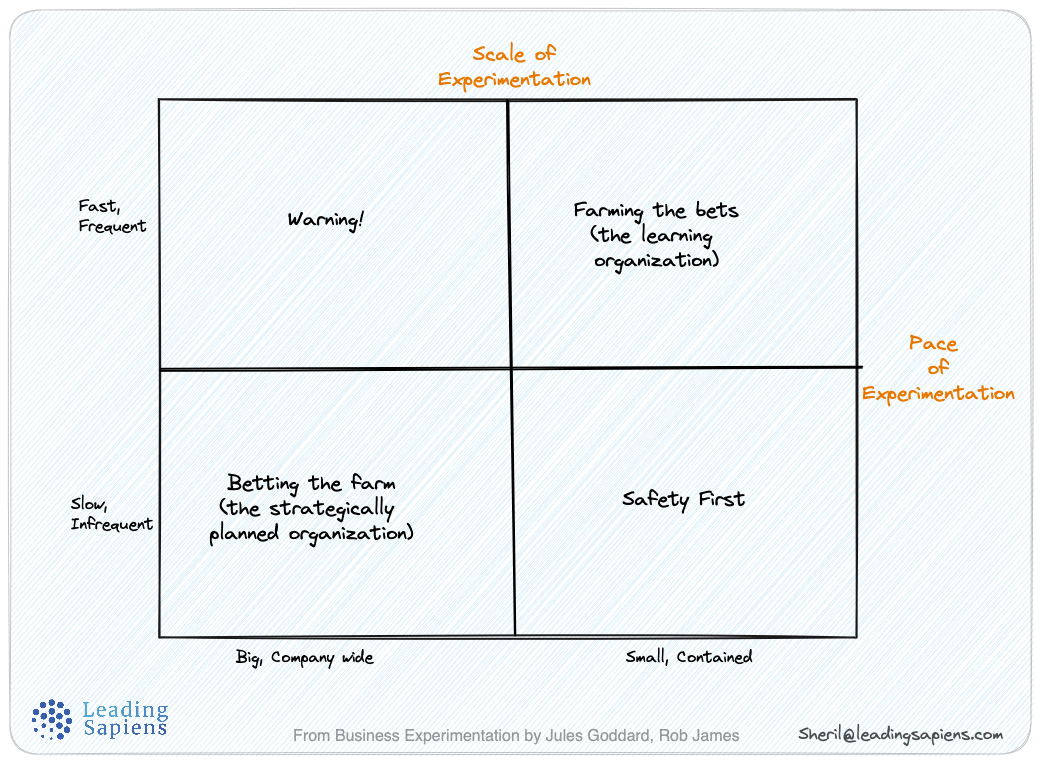
Think Big Video:
9. Bias for Action
Speed matters in business. Many decisions and actions are reversible and do not need extensive study. We value calculated risk taking.
In Bezos’ own words:
- In addition to good luck and great people, we have been able to succeed as a company only because we have continued to take big risks.
- The most important factor for nimbleness is decision-making speed. The second-most important factor is being willing to be experimental. You have to be willing to take risks.
- ...never use a one-size-fits-all decision-making process. Many decisions are reversible, two-way doors.
Some pointers:
- Bias for action was one of the key findings of successful companies in Tom Peters and Robert Waterman's classic In Search of Excellence.
- Waiting for clarity can be a mistake. Often action creates clarity, and generates it's own intelligence:
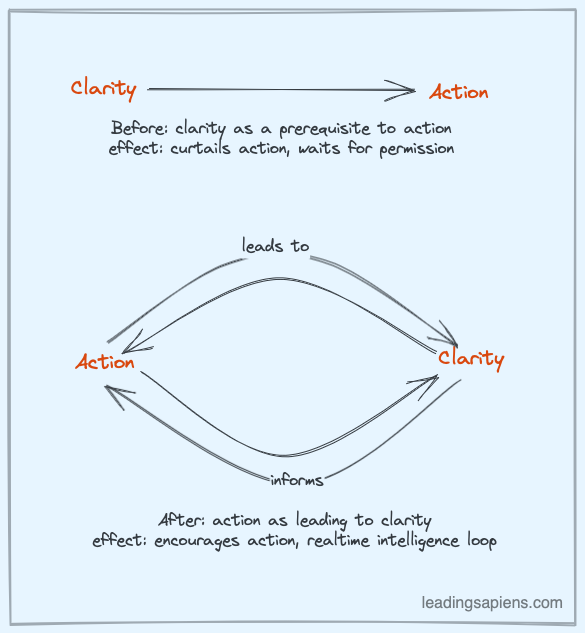
Bias for Action Video:
10. Frugality
Accomplish more with less. Constraints breed resourcefulness, self-sufficiency and invention. There are no extra points for growing headcount, budget size or fixed expense.
In Bezos’ own words:
- In the short run, the market is a voting machine but in the long run, it is a weighing machine.
- Our ultimate financial measure, and the one we most want to drive over the long-term, is free cash flow per share.
- When something seems like an opportunity...you will always get asked the question, ‘Why? Why do that?' But ‘Why not?’ is an equally valid question.
- The whole point of moving things forward is that you run into problems, failures, things that don’t work...you’re trying to invent your way out of a box.
Example:
You can’t afford to pursue inventions for very long if you spend your money on things that don’t lead to a better customer experience, like trade show booths, big teams, and splashy marketing campaigns. Amazon Music and Prime Video are examples of how we kept our investment manageable for many years by being frugal: keeping the team small, staying focused on improving the customer experience, limiting our marketing spend, and managing the P&L carefully.
Once we had a clear product plan and vision for how these products could become billion-dollar businesses that would delight tens, even hundreds of millions of consumers, we invested big. Patience and carefully managed investment over many years can pay off greatly.
– Colin Bryar, Bill Carr [5]
Some pointers:
- Being resourceful requires examining hidden constraints and assumptions — we have to understand how many of our mental models are hidden:
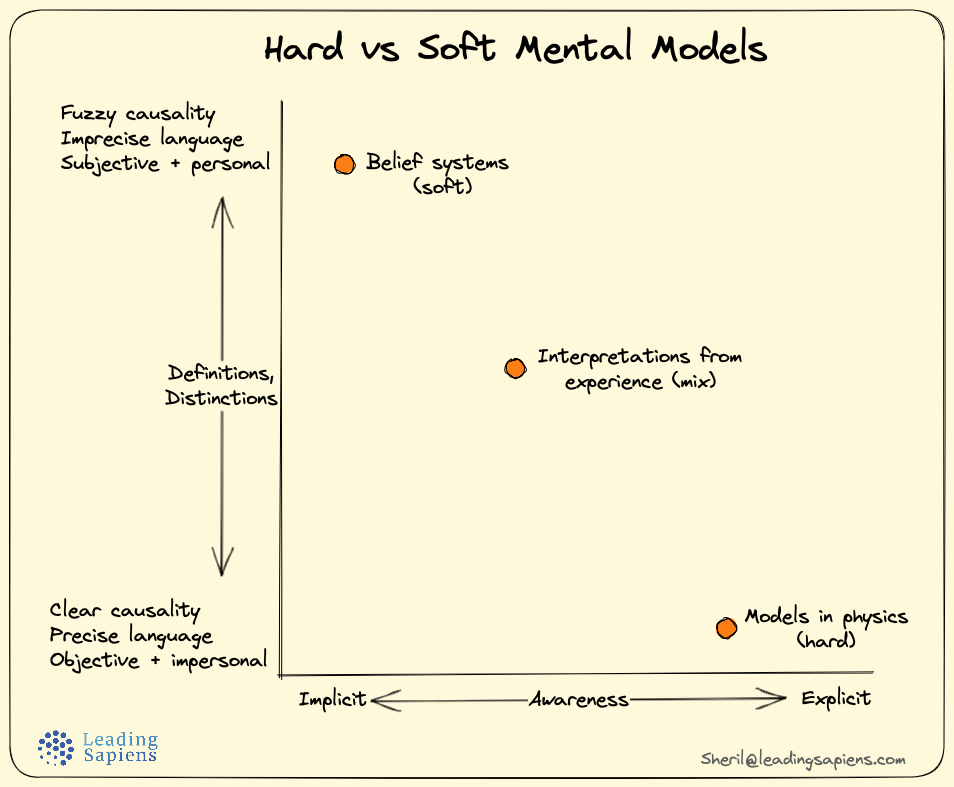
Frugality Video:
11. Earn Trust
Leaders listen attentively, speak candidly, and treat others respectfully. They are vocally self-critical, even when doing so is awkward or embarrassing. Leaders do not believe their or their team’s body odor smells of perfume. They benchmark themselves and their teams against the best.
In Bezos’ own words:
- It’s not easy to do hard things well, but that’s how you earn trust.
- Our pricing objective is to earn customer trust, not to optimize short-term profit dollars.
Peter Drucker [8] highlighted the importance of trust in effective leadership:
The final requirement of effective leadership is to earn trust. Otherwise, there won’t be any followers—and the only definition of a leader is someone who has followers.
To trust a leader, it is not necessary to like him. Nor is it necessary to agree with him. Trust is the conviction that the leader means what he says. It is a belief in something very old-fashioned, called “integrity.” A leader’s actions and a leader’s professed beliefs must be congruent, or at least compatible.
Effective leadership—and again this is very old wisdom—is not based on being clever; it is based primarily on being consistent.
Some pointers:
- Trust requires authenticity. But authenticity in leadership is different from its commonly understood meaning. E.g., a simple way to build more trust is to know intimately how your teams actually get work done.
- A useful tool to understand your blindspots and to build trust is the Johari Window:
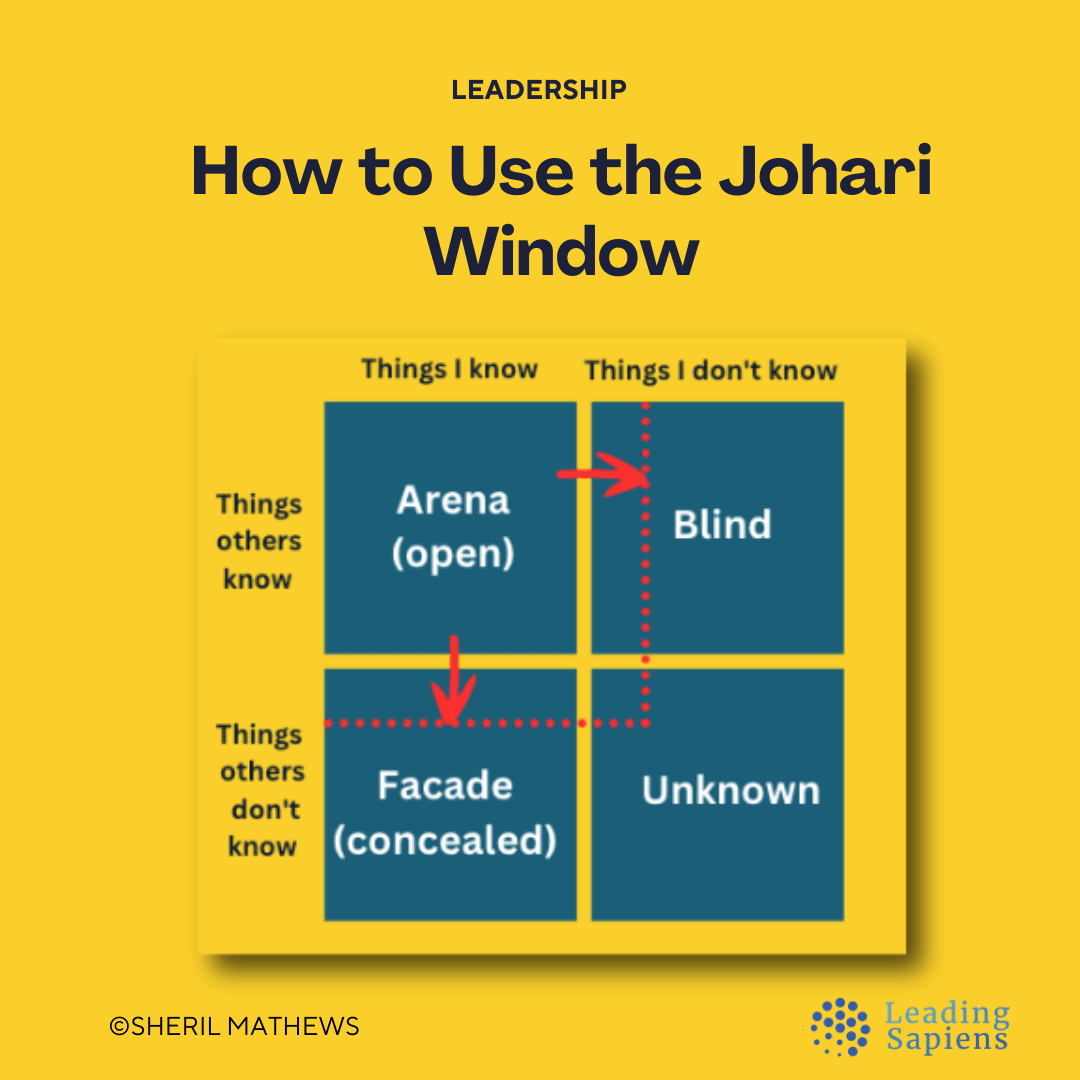
- Being self-critical requires a high degree of humility and a cultivated form of naivete:
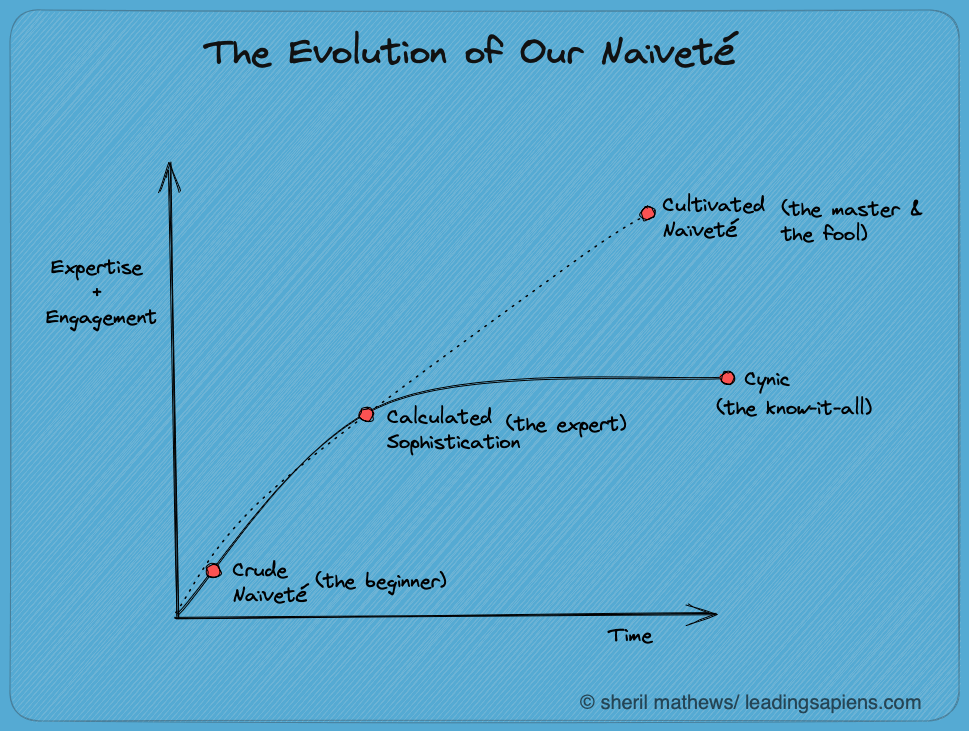
Earn Trust Video:
12. Dive Deep
Leaders operate at all levels, stay connected to the details, audit frequently, and are skeptical when metrics and anecdote differ. No task is beneath them.
In Bezos’ own words:
- "It’s always worth asking, do we own the process or does the process own us?"
- "The thing I have noticed is that when the anecdotes and the data disagree, the anecdotes are usually right. There’s something wrong with the way you’re measuring it."
Examples:
- Diving deep means being intimately familiar with all aspects. Bezos himself was known for working at Amazon's fulfillment centers.
- Amazon's famed 6-page memos, that emphasize narratives instead of powerpoint, act as a forcing function for both reader and writer to dive deeper:
The down side to the 6-pager is that writing a good six-page evidence-based narrative is hard work. Precision counts and it can be hard to summarize a complex business in 6 pages, so teams work for hours preparing the document for these reviews. But that preparation does two things.
First, it requires the team writing the document to really deeply understand their own space, gather their data, understand their operating tenets and be able to communicate them clearly. The second thing it does is a great document enables our senior executives to internalize a whole new space they may not be familiar with in 30 minutes of reading thus greatly optimizing how quickly and how many different initiatives these leaders can review.
– Brad Porter
Some pointers:
- Breakthroughs and innovation often come as after-effects of deep engagement, rather than detached isolation. MBWA, pioneered by HP, ensures that managers stay close to critical issues as they emerge, both within and outside the organization.
- In leadership roles, it's easy to manage by proxy — far removed from the action, and understanding the business only through numbers, KPIs, and metrics. The "dive deep" principle acts as a counter to this common tendency.
- It's also a counter-balance to the "think big" principle. Big picture thinking frequently translates into leaving the nitty-gritty to others. It's one way how leaders botch strategy. But execution is as critical as strategy, even more so. Dive deep ensures leaders stay close to the action.
At many companies, when the senior leadership meets, they tend to focus more on big-picture, high-level strategy issues than on execution. At Amazon, it’s the opposite. Amazon leaders toil over the execution details...
– Colin Bryar, Bill Carr
Dive Deep video:
13. Have Backbone; Disagree and Commit
Leaders are obligated to respectfully challenge decisions when they disagree, even when doing so is uncomfortable or exhausting. Leaders have conviction and are tenacious. They do not compromise for the sake of social cohesion. Once a decision is determined, they commit wholly.
In Bezos’ own words:
- People are entitled to their opinions, but it is the job of a senior leadership team to say no.
- ...use the phrase “disagree and commit.” This phrase will save a lot of time.
- It’s a genuine disagreement of opinion, a candid expression of my view, a chance for the team to weigh my view, and a quick, sincere commitment to go their way.
Some pointers:
- Having backbone in organizational setups is a very particular kind of existential courage, that's different from the common notions of courage we usually think of.
History:
This principle has a pedigree as it originated at Intel during its heyday. Their's went by the version of : "Practice constructive confrontation. Argue and debate regardless of rank, and then commit once a decision is made—disagree and commit." [9]
Business guru Jim Collins [9] explains it this way:
During its rise from entrepreneurial start-up to great company, Intel installed a mechanism for decision making called “constructive confrontation.” As a member of the Intel team, you carried the burden to argue, debate, and disagree to help solve pressing problems. It didn’t matter whether you were a junior engineer or field-marketing person; if you felt the logic and facts pointed to a solution contrary to that proposed by other people in the room, even contrary to the views of the CEO, you were expected to argue for that solution.
Intel’s culture of constructive confrontation (sometimes referred to as “disagree and commit”) exemplifies a pattern of decision making cultivated by Level 5 leaders in our research. They stimulated dialogue, debate, and disagreement as an indispensable ingredient in making supremely good decisions. They also created a climate where evidence, logic, and facts would trump personality, power, and politics.
As a member of a Level 5 team, you have not only the opportunity to engage in the dialogue, you have the responsibility to do so. If you fail to advance your argument, if you fail to disagree with the most powerful person in the room, if you fail to bring solid logic and evidence to the debate, if you attack a person rather than the problem, then you’re failing in that responsibility.
14. Deliver Results
Leaders focus on the key inputs for their business and deliver them with the right quality and in a timely fashion. Despite setbacks, they rise to the occasion and never settle.
In Bezos’ own words:
- ...we believe that focusing our energy on the controllable inputs to our business is the most effective way to maximize financial outputs over time.
- The whole point of moving things forward is that you run into problems, failures, things that don’t work.
Some pointers:
- Notice the emphasis on inputs that are more in our control, rather than outcomes. Focusing on process goals rather than outcomes goals is a key aspect of goal-setting research. Amazon takes this notion one step further by creating input metrics for almost everything imaginable. John Rossman calls this a focus on real-time instrumentation in contrast with metrics that are often lagging.
Input metrics track things like selection, price, or convenience—factors that Amazon can control through actions such as adding items to the catalog, lowering cost so prices can be lowered, or positioning inventory to facilitate faster delivery to customers.
Output metrics—things like orders, revenue, and profit—are important, but they generally can’t be directly manipulated in a sustainable manner over the long term. Input metrics measure things that, done right, bring about the desired results in your output metrics.
...
Controllable input metrics are a quantitative (diving deep with data) and qualitative (anecdotes) way of measuring how well the organization is satisfying these customer interests so that the output metrics trend the way the company desires.
– Colin Bryar, Bill Carr
Deliver Results Video:
New additions
Principles 15 and 16 have been recently added. I will be updating them, as I find more details. But they are fairly self-explanatory and stem from the various criticisms Amazon has faced over the years. It's a natural offshoot of how big they've become, and the resulting impact.
In Bezos' own words:
- "Despite what we’ve accomplished, it’s clear to me that we need a better vision for our employees’ success. We have always wanted to be Earth’s Most Customer-Centric Company. We won’t change that. It’s what got us here. But I am committing us to an addition. We are going to be Earth’s Best Employer and Earth’s Safest Place to Work."
15. Strive to be Earth’s Best Employer
Leaders work every day to create a safer, more productive, higher performing, more diverse, and more just work environment. They lead with empathy, have fun at work, and make it easy for others to have fun. Leaders ask themselves: Are my fellow employees growing? Are they empowered? Are they ready for what’s next? Leaders have a vision for and commitment to their employees’ personal success, whether that be at Amazon or elsewhere.
Some pointers:
- There's a fundamental difference between leaders who control vs. those who help release people's creative energies.
- To be effective, leaders have to understand people and what gives them meaning.
- Leading with context is fundamentally different from leading by control. It's why leading by context is a key tenet at Netflix:
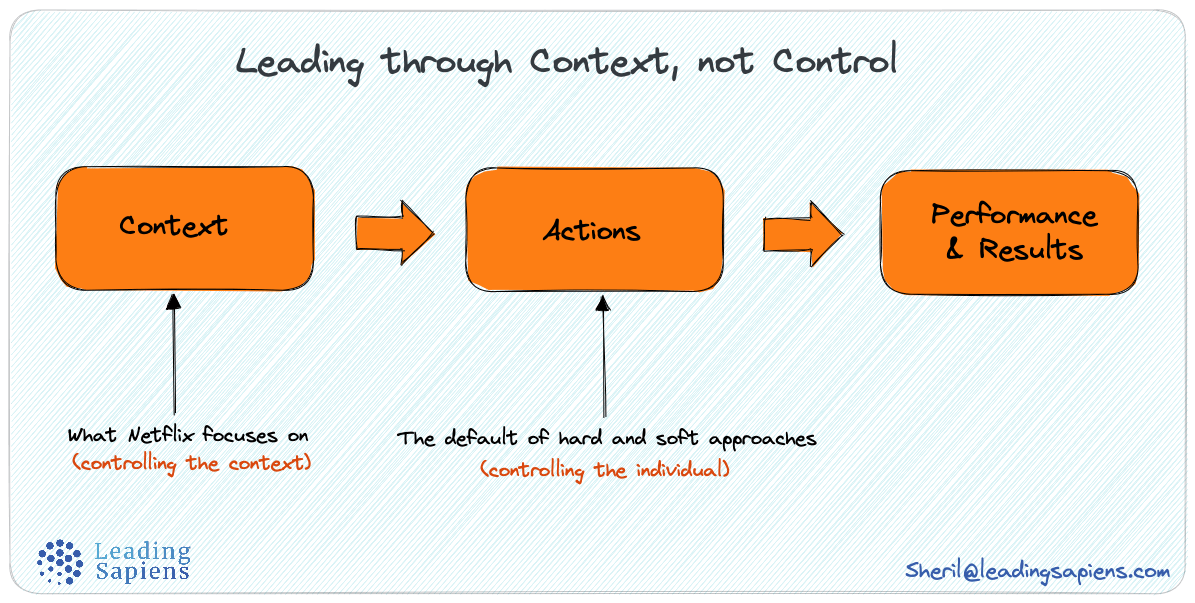
Video:
16. Success and Scale Bring Broad Responsibility
We started in a garage, but we’re not there anymore. We are big, we impact the world, and we are far from perfect. We must be humble and thoughtful about even the secondary effects of our actions. Our local communities, planet, and future generations need us to be better every day. We must begin each day with a determination to make better, do better, and be better for our customers, our employees, our partners, and the world at large. And we must end every day knowing we can do even more tomorrow. Leaders create more than they consume and always leave things better than how they found them.
In Bezos’ own words:
- If you want to be successful in business (in life, actually), you have to create more than you consume.
Video:
Andy Jassy on iterative innovation
In his very first shareholder letter (2021), Bezos' successor Andy Jassy outline some key components of what he called "iterative innovation". He hits on many of the key ideas in a fresh take:
1/ Hire the Right Builders: We disproportionately index in hiring builders. We think of builders as people who like to invent, who look at customer experiences, dissect what doesn’t work well about them, and seek to reinvent them. We want people who keep asking why can’t it be done? We want people who like to experiment and tinker, and who realize launch is the starting line, not the finish line.
2/ Organize Builders into Teams That Are as Separable and Autonomous as Possible: It’s hard for teams to be deep in what customers care about in multiple areas. It’s also hard to spend enough time on the new initiatives when there’s resource contention with the more mature businesses; the surer bets usually win out. Single-threaded teams will know their customers’ needs better, spend all their waking work hours inventing for them, and develop context and tempo to keep iterating quickly.
3/ Give Teams the Right Tools and Permission to Move Fast: Speed is not pre-ordained. It’s a leadership choice. It has trade-offs, but you can’t wake up one day and start moving fast. It requires having the right tools to experiment and build fast (a major part of why we started AWS), allowing teams to make two-way door decisions themselves, and setting an expectation that speed matters. And, it does. Speed is disproportionally important to every business at every stage of its evolution. Those that move slower than their competitive peers fall away over time.
4/ You Need Blind Faith, But No False Hope: This is a lyric from one of my favorite Foo Fighters songs (“Congregation”). When you invent, you come up with new ideas that people will reject because they haven’t been done before (that’s where the blind faith comes in), but it’s also important to step back and make sure you have a viable plan that’ll resonate with customers (avoid false hope).
We’re lucky that we have builders who challenge each other, feedback loops that give us access to customer feedback, and a product development process of working backwards from the customer where having to write a Press Release (to flesh out the customer benefits) and a Frequently Asked Questions document (to detail how we’d build it) helps us have blind faith without false hope (at least usually).
5/ Define a Minimum Loveable Product (MLP), and Be Willing to Iterate Fast: Figuring out where to draw the line for launch is one of the most difficult decisions teams must make. Often, teams wait too long, and insist on too many bells and whistles, before launching. And, they miss the first mover advantage or opportunity to build mindshare in fast-moving market segments before well-executing peers get too far ahead. The launch product must be good enough that you believe it’ll be loved from the get-go (why we call it a “Minimum Loveable Product” vs. a “Minimum Viable Product”), but in newer market segments, teams are often better off getting this MLP to customers and iterating quickly thereafter.
6/ Adopt a Long-term Orientation: We’re sometimes criticized at Amazon for not shutting much down. It’s true that we have a longer tolerance for our investments than most companies. But, we know that transformational invention takes multiple years, and if you’re making big bets that you believe could substantially change customer experience (and your company), you have to be in it for the long-haul or you’ll give up too quickly.
7/ Brace Yourself for Failure: If you invent a lot, you will fail more often than you wish. Nobody likes this part, but it comes with the territory. When it’s clear that we’ve launched something that won’t work, we make sure we’ve learned from what didn’t go well, and secure great landing places for team members who delivered well—or your best people will hesitate to work on new initiatives.
Interviewing tips and reading recommendations
Between this and the Bezos' mental models article, you should be well-prepared for questions on Amazon’s leadership principles. The key is to tie each principle to real examples from your own experience. If you want to dig even further, below are some additional resources.
Articles
- Amazon recruiters' tips on interviewing: https://www.aboutamazon.com/news/workplace/recruiters-offer-their-best-tips-for-interviewing-at-amazon
- Tips from the Amazon jobs site, including the STAR framework: https://www.amazon.jobs/en/landing_pages/in-person-interview
- Interviewing tips from the authors of Working Backwards: https://www.workingbackwards.com/resources/10-tips-how-to-ace-amazon-interview
- Jeff Wilke on the leadership principles from Amazon's blog: https://www.aboutamazon.com/news/workplace/avoiding-the-perils-of-scrappy
- Behavioral interviewing tips from a former Amazon VP: https://www.scarletink.com/interviewing-at-amazon-leadership-principles/
- 2015 New York Times article on their work culture: https://www.nytimes.com/2015/08/16/technology/inside-amazon-wrestling-big-ideas-in-a-bruising-workplace.html
- 2014 article in Business Insider where Henry Blodgett interviews Bezos: https://www.businessinsider.com/amazons-jeff-bezos-on-profits-failure-succession-big-bets-2014-12
- Another Amazon VP's article: http://jeff-barr.com/2014/08/19/my-first-12-years-at-amazon-dot-com/
- Jeff Wilke leadership advice: https://www.geekwire.com/2017/leadership-advice-amazon-keeps-managers-focused-competing-many-industries/
Books
- Invent and Wander: The Collected Writings of Jeff Bezos, with an Introduction by Walter Isaacson
- Working Backwards: Insights, Stories, and Secrets from Inside Amazon by Colin Bryar, Bill Carr
- The Amazon Management System by Ram Charan and Julia Yang
- The Amazon Way by John Rossman
Invent and Wander is a collection of Bezos's shareholder letters and other written material from a range of sources. It has a great introduction by Walter Isaacson. Even though all the sources are available online, the book does a great job of compiling them into a convenient, accessible form.
As a complement to Invent and Wander, Working Backwards is the most comprehensive with many in-depth examples. The book benefits from both the authors being at Amazon for 15+ years through the periods of highest growth.
Amazon Management System is a concise introduction to all the principles wrapped into a system. If you want a short preview, check out my summary post of the book.
Amazon Way is a short read with decent examples from Rossman's days at Amazon.
For a slightly darker, more realistic, take on the realities of practical application of these principles, check out Brad Stone's The Everything Store and Amazon Unbound. These are a lot more than just the leadership principles, and more of a grander narrative.
Videos
- Bezos in interview with David Rubinstein: https://youtu.be/f3NBQcAqyu4
- HBR Podcast: https://hbr.org/podcast/2013/01/jeff-bezos-on-leading-for-the
- Bezos at Bush Forum on Leadership:
Sources
- Amazon shareholder letters
- Amazon leadership principles
- Amazon leadership principles videos
- Invent and Wander: The Collected Writings of Jeff Bezos, with an Introduction by Walter Isaacson
- Working Backwards: Insights, Stories, and Secrets from Inside Amazon by Colin Bryar, Bill Carr
- The Amazon Management System by Ram Charan and Julia Yang
- The Amazon Way by John Rossman
- The Essential Drucker by Peter Drucker
- BE 2.0 (Beyond Entrepreneurship 2.0) by Jim Collins


